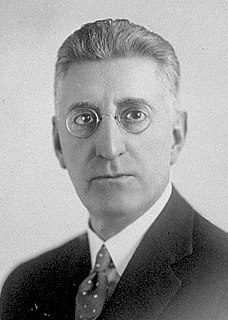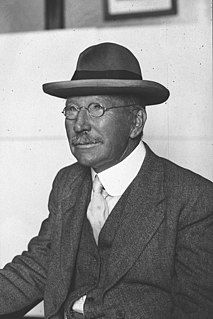
Reginald Walter Darcy Weaver was an Australian conservative parliamentarian who served in the New South Wales Legislative Assembly for 28 years. Serving from 1917 in the backbenches, he entered the cabinet of Thomas Bavin in 1929 as Secretary for Mines and Minister for Forests until he returned to opposition in 1930. Following the success of the United Australia Party in the 1932 election, Weaver returned as the Secretary for Public Works and Minister for Health in the Stevens ministry.

Bourke was an electoral district of the Legislative Assembly in the Australian state of New South Wales from 1880 to 1904, including the towns of Bourke and Cobar. It elected two members simultaneously between 1882 and 1889 increasing to three members until 1894, with each elector being able to vote for as many candidates as there were vacancies.
Burrangong was an electoral district of the Legislative Assembly in the Australian state of New South Wales created in the 1904 re-distribution of electorates following the 1903 New South Wales referendum, which required the number of members of the Legislative Assembly to be reduced from 125 to 90. It was named after Burrangong station, the first squatting run in the Young area and consisted of parts of the abolished districts of Boorowa, Grenfell and Young. In 1920, with the introduction of proportional representation, it was absorbed along with Yass into Cootamundra.
Ashburnham was an electoral district of the Legislative Assembly in the Australian state of New South Wales, originally created in 1894 in the Parkes area and named after Ashburnham County. In 1920, with the introduction of proportional representation, it was absorbed into Murrumbidgee, along with Lachlan. It was recreated in 1927 and abolished in 1950.

Sir George Stephenson Beeby KBE was an Australian politician, judge and author. He was one of the founders of the Labor Party in New South Wales, and represented the party in state parliament from 1907 to 1912. He fell out with the party and later served as an independent, a Nationalist, and a Progressive. He left parliament in 1920 to join the state arbitration court, and in 1926 was appointed to the Commonwealth Court of Conciliation and Arbitration. He was Chief Judge from 1939 until his retirement in 1941.

Arthur Hill Griffith was a politician, teacher and patent attorney in New South Wales, Australia. He was a member of the New South Wales Legislative Assembly from 1894 until 1917 and held a number of ministerial positions in the Government of New South Wales. He was a member of the Labor Party (ALP).
Murrumbidgee, an electoral district of the Legislative Assembly in the Australian state of New South Wales, has existed from the establishment of the Legislative Assembly in 1855 until its abolition in 2011.

Niels Rasmus Wilson Nielsen was a Danish-born politician and union official in New South Wales, Australia.
Cootamundra, an electoral district of the Legislative Assembly in the Australian state of New South Wales, was created in 1904 and was abolished in 1941, returning one member until 1920, three members from 1920 to 1927 and one member from 1927 to 1941. It was recreated in 2015.

James Archibald Mackinnon was a politician and stock and station agent in New South Wales, Australia.
The 1917 New South Wales state election involved 90 electoral district returning one member each. If a candidate failed to achieve at least 50% of the vote in an electorate, a run-off election would take place in the following weeks. In this election, 8 electorates proceeded to second round elections.
This is a list of electoral district results for the 1913 New South Wales state election.
The 1904 New South Wales state election involved 90 electoral districts returning one member each. The election was conducted on the basis of a simple majority or first-past-the-post voting system. There were two significant changes from the 1901 election, the first was that women were given the right to vote, which saw an increase in the number of enrolled voters from 345,500 in 1901, to 689,490 in 1904. The second was that as a result of the 1903 New South Wales referendum, the number of members of the Legislative Assembly was reduced from 125 to 90. The combined effect of the changes meant that the average number of enrolled voters per electorate went from 2,764, to 7,661, an increase of 277%. Leichhardt was the only district that was not substantially changed, while The Macquarie and The Murray districts retained nothing but the name.
Burrangong, an electoral district of the Legislative Assembly in the Australian state of New South Wales was created in 1904 and abolished in 1920.
A by-election was held for the New South Wales Legislative Assembly electorate of Goldfields South on 16 November 1863 because Bowie Wilson had been appointed Secretary for Lands in the first Martin ministry. Such ministerial by-elections were usually uncontested and on this occasion, Peter Faucett (Yass), William Forster and Arthur Holroyd (Parramatta) were unopposed. Of the other two contested elections, Geoffrey Eagar was easily re-elected, with more than 90% of the vote, while James Martin was defeated at the Orange by-election. Martin promptly regained a seat in parliament by winning the by-election for The Tumut.
A by-election was held for the New South Wales Legislative Assembly electorate of Goldfields South on 12 December 1870 as a result of the Legislative Assembly declaring the election of Ezekiel Baker was void. Baker had been appointed to conduct a Royal Commission to inquire into the laws and regulations of the goldfields and for securing a permanent water supply. The Committee of Elections and Qualifications held that this appointment was an office of profit under the crown which meant he was incapable of being elected, or of sitting, or voting, as a member of the Assembly.
Grenfell, an electoral district of the Legislative Assembly in the Australian state of New South Wales was created in 1880 and abolished in 1904.
Surry Hills, an electoral district of the Legislative Assembly in the Australian state of New South Wales had two incarnations, from 1904 until 1920 and from 1927 until 1930.
A by-election was held for the New South Wales Legislative Assembly electorate of Cootamundra on 28 July 1906 because of the resignation of William Holman (Labour). John Norton blamed Holman for a series of articles in The Worker commenting on Norton's unnatural silence over the land scandals involving Paddy Crick and William Willis. Norton made a personal attack on Holman in parliament, challenging him to resign and both would contest Holman's seat of Cootamundra.

George Grimm was a minister and Moderator of the Presbyterian Church of New South Wales, Australia.







